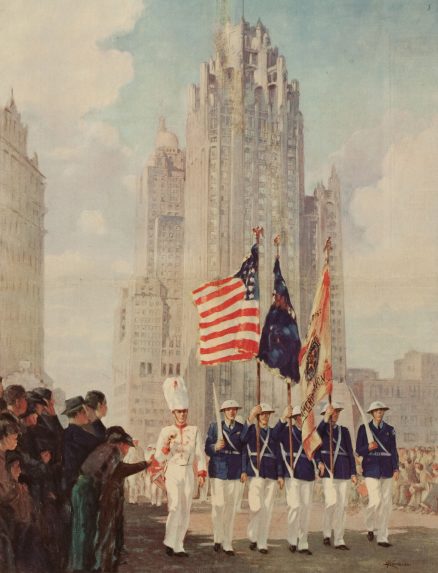Over the Top in 1933 (Armistice Day)
, dated [19]33Oil on canvas, 39 by 49 inches
- Zoom in on Artwork
- Print Page
- Email Page to Friend
Eager spectators line the way as three uniformed flag-bearers flanked by rifle-toting escorts and a drum major march south across Chicago’s Michigan Avenue Bridge in Jerome Klapka’s Over the Top in 1933. A fluttering Stars and Stripes dominates the center of the vertical composition; to its right is a light-colored banner displaying the emblem of the American Legion, with an unidentified dark-blue-and-gold flag between them. Rising in the background are the Tribune Tower and the Medinah Athletic Club (now part of the InterContinental Chicago Hotel), with the Wrigley Building framing the view on the left. A blue sky with billowing white clouds complements the upbeat mood of this patriotic image, in which the neutral tones of the backdrop and spectators set off the brilliant whites and blues of the marchers’ uniforms. Klapka’s solidly representational style bespeaks his training as a commercial artist. He likely painted Over the Top in 1933 in the studio from photographs or sketches made on site.
At the height of the Great Depression, as Chicago celebrated its Century of Progress Exposition, the opening of the fifteenth annual congress of the American Legion on October 3, 1933, was marked by a parade promoted as the largest ever staged in North America. Watched by crowds estimated in the hundreds of thousands, it featured a reported 120,000 military veterans, 350 bands, 200 drum corps, and 250 floats. Kicking off at the bridge at ten o’clock in the morning, the entire parade reached Soldier Field a mile and a half away after seven that evening. This “masterpiece of military precision and of civic opulence” (in the Chicago Tribune’s estimation) was intended to support President Franklin Delano Roosevelt’s call for national unity during a process of economic reconstruction as urgent as national defense in wartime.i “Going over the top” was an expression used during World War I to describe abandoning the relative safety of the trenches to risk open fire on the battlefield. In Klapka’s painting, “over the top” describes one segment of the parade getting under way and, metaphorically, the nation setting out to tackle daunting economic challenges.
Over the Top in 1933 was perhaps Klapka’s best-known image. The American Legion reproduced it on brochures for its conventions in 1934 and again in 1946 and 1952. In 1936, it was reproduced on the front covers of both the Chicago Tribune’s rotogravure section and the Medinah Athletic Club members’ magazine, where it was erroneously titled Armistice Day in reference to the November 11 commemoration of the end of World War I, the holiday known since 1954 as Veterans Day.
Wendy Greenhouse, PhD
Donated by M. Christine Schwartz to the Pritzker Military Museum & Library, Chicago, Illinois, in 2022
i James O’Donnell Bennett, “Chicago Throngs Cheer March of Vets,” Chicago Tribune, Oct. 4, 1933.
